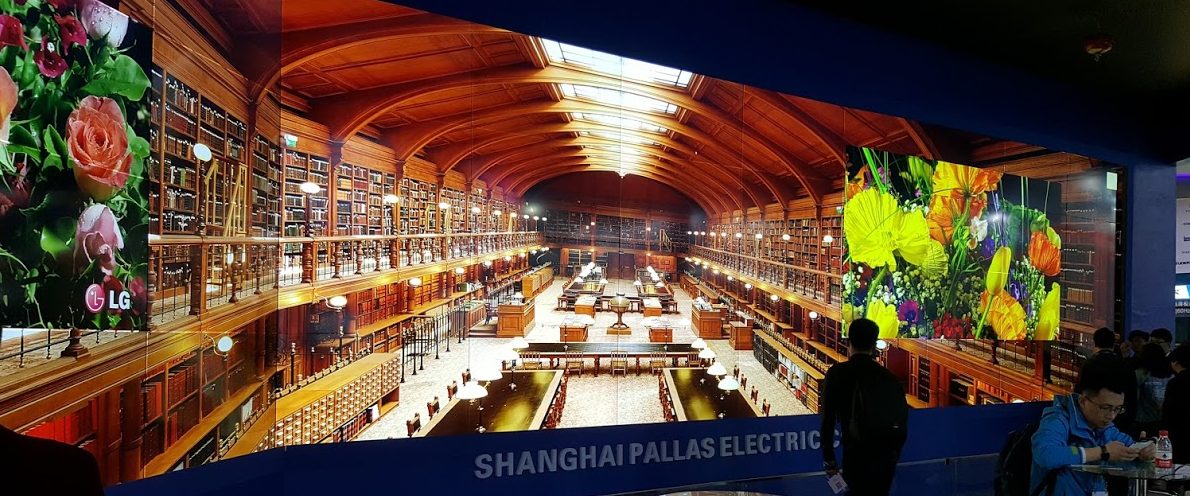
InfoComm China: An LCD Video Wall With Kinda Sorta No Visible Seams
April 12, 2017 by Dave Haynes
Probably the most interesting thing I saw in a quick walk around several halls at InfoComm China in Beijing on Wednesday was a Shanghai company called Pallas, which has tech that does a really good job of making the seams in LCD video walls visually go away.
It uses something called active bezel tech – which the guy at the booth told me was using LED. His English was so-so and my Mandarin was non-existent, so I couldn’t get a lot of detail. The company website and print brochures are long on how it looks and short on how it works. But the company has a pile of patents.
I thought, looking at it in the booth, that these were plastic overlays about the width of a finger filling the gaps between LCDs, picking up and kind of reflecting the video from the edges of the panels. But these strips are evidently active LED strips of some kind, that are fused to the top and left side of LCD panels. When they are joined in a wall format, it makes the narrow bezels visually go away. At least somewhat.
You can definitely see seams, but they are faint and light as opposed to black and much more evident.
This is not retrofit tech you’d add to a Samsung or NEC panel. You buy Pallas LCDs with this integrated in. The company says it has been working on this since 2003, and what was shown is the 7th generation version.
The company has distributorships in several countries, and has been marketing the product for a few years. They were at ISE in 2016, but I didn’t notice them among the 100s of companies there.
My guess is display industry guys at the major manufacturers know more about this, and would have a story on why this tech doesn’t seem to be all that widely used. The company does reference some accounts like TV studios (including CNN), control rooms and corporate lobbies. It may be price. It may be that
Anyone have a solid explanation on how this stuff works? Looking at you, Rich Ventura. Use the comments section and fill me/us in.
Here’s a video rAVe shot at ISE last year. Kinda reflects my own language gap experience getting the tech explained.



I’ve seen something very similar to this a couple of years ago at ISE which was a clear plastic lens arrangement that takes the edge pixels from each screen and stretches them into each other across the join. Think of it as a pair of very wide periscopes that direct the light into your eyes from the pixels, making it look as though it came from the bezel join.
Just like this one it looked pretty good from a distance from a 90 degree angle but from the sides you see too-dark and too-light strips. I find the too-light strip a lot more visually distracting than the usual too-dark bezel.
Probably quite good as a TV studio backdrop – way cheaper than LED and lacking the Dean Martin problem (it’s a moire) but if the main viewing angle is widely spread I couldn’t recommend it.
It also has to be specially made for every exact screen (based on exact dimensions and bezel width) which is I assume why it’s only available for their screens.